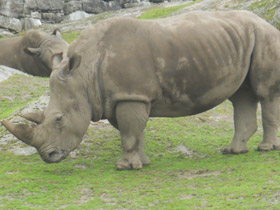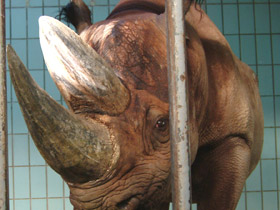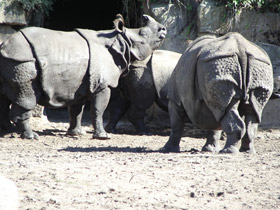The rhinoceros, 'nose-horned' and rhinoceros or rhinoceroses (Rhinocerotidae)
A rhinoceros (/raɪˈnɒsərəs/; from Ancient Greek ῥῑνόκερως (rhīnókerōs) 'nose-horned'; from ῥῑ́ς (rhī́s) 'nose', and κέρας (kéras) 'horn'; pl.: rhinoceros or rhinoceroses), commonly abbreviated to rhino, is a member of any of the five extant species (or numerous extinct species) of odd-toed ungulates in the family Rhinocerotidae; it can also refer to a member of any of the extinct species of the superfamily Rhinocerotoidea. Two of the extant species are native to Africa, and three to South and Southeast Asia.
Taxonomy and naming
The word rhinoceros is derived through Latin from the Ancient Greek: ῥῑνόκερως, which is composed of ῥῑνο- (rhino-, "nose") and κέρας (keras, "horn") with a horn on the nose. The name has been in use since the 14th century.
The family Rhinocerotidae consists of only four extant genera: Ceratotherium (white rhinoceros), Diceros (black rhinoceros), Dicerorhinus (Sumatran rhinoceros), and Rhinoceros (Indian and Javan rhinoceros). The living species fall into three categories. The two African species, the white rhinoceros and the black rhinoceros, belong to the tribe Dicerotini, which originated in the middle Miocene, about 14.2 million years ago. The species diverged during the early Pliocene (about 5 million years ago). The main difference between black and white rhinos is the shape of their mouths – white rhinos have broad flat lips for grazing, whereas black rhinos have long pointed lips for eating foliage. There are two living Rhinocerotini species, the Indian rhinoceros and the Javan rhinoceros, which diverged from one another about 10 million years ago. The Sumatran rhinoceros is the only surviving representative of the Dicerorhinini.
A subspecific hybrid white rhino (Ceratotherium s. simum × C. s. cottoni) was bred at the Dvůr Králové Zoo (Zoological Garden Dvur Kralove nad Labem) in the Czech Republic in 1977. Interspecific hybridisation of black and white rhinoceroses has also been confirmed.
While the black rhinoceros has 84 chromosomes (diploid number, 2N, per cell), all other rhinoceros species have 82 chromosomes. Chromosomal polymorphism might lead to varying chromosome counts. For instance, in a study there were three northern white rhinoceroses with 81 chromosomes.
Origin and description
Rhinocerotidae are a family of placental mammals of the suborder ceratomorphs belonging to the order Perissodactyla.
Rhinocerotidae resemble dinosaurs in their gigantic size, their gawkiness and a kind of primitive power. Of course, the most striking is the extinct hornless rhinoceros Indricatherium, which was the largest land mammal, reaching 8 metres in height and weighing 20 tonnes, but the species that have survived to the present day weigh up to 3,600 kg and are over 4 metres long.
Rhinos have a heavy physique, with a short, thick neck, a large, elongated head with small, laterally set eyes and a slender tail. Their upper lip is strongly developed and mobile, their ears are long, protruding, oval with a small tuft of hair on top. The short, thick limbs of Rhinocerotidae have three toes each, ending in broad hooves, and the skin of these giants is very thick and almost hairless. Rhinocerotidae have poor eyesight but an excellent sense of smell and hearing. Their main distinguishing feature is undoubtedly the horns on their nose (the name rhinoceros comes from two Greek words: rhinoceros 'nose' and keras 'horn'). Despite their toughness, the horns are not made of bone, but of the finest parallel, hollow horn fibres of keratin (a protein found in human hair and nails). The largest known rhino horn measured 158 cm.
Habitat and lifestyle
Rhinocerotidae live in savannahs, forests and thickets. They live singly or in pairs, sometimes in small groups of 5-7 animals. Rhinocerotidae sleep during the day and become active at dusk and at night. Rhinocerotidae like to swim and wallow in mud and tend to stay in places not too far from water. These wary animals tend to avoid proximity to humans, but when they are upset, injured or very frightened, they will rush furiously towards their enemies. When fleeing, they reach speeds of up to 40 km/h and then strike out with their horns. With their enormous strength and mass, rhinos can cause serious injury to humans.
Reproduction
After a gestation period of 15 to 18 months, the female gives birth to a calf, which is suckled by its mother for two years and is not separated from her until it is 3.5 years old. Rhinocerotidae reach sexual maturity at a later age: females at 4 years and males at 6-7 years, but begin to reproduce later. Females give birth to their first offspring at 5-7 years of age, males may become fathers no earlier than 10 years of age (until they reach a sufficiently high social rank, adult males keep them away from females).
Unfortunately, the numbers of Rhinocerotidae have declined drastically in recent decades due to overhunting, and they are kept almost exclusively in national parks. There, too, they continue to be killed, mainly for their horns, which are highly valued in oriental medicine.
Conservation status
The family Rhinocerotidae contains 61 genera, 57 of which are extinct. There are currently only five rhinoceros species left on Earth, two in Africa and three in Asia. All of them are listed by the International Union for Conservation of Nature.
Species
White
There are two subspecies of white rhinoceros: the southern white rhinoceros (Ceratotherium simum simum) and the northern white rhinoceros (Ceratotherium simum cottoni). As of 2013, the southern subspecies has a wild population of 20,405—making them the most abundant rhino subspecies in the world. The northern subspecies is critically endangered, with all that is known to remain being two captive females. There is no conclusive explanation of the name "white rhinoceros". A popular idea that "white" is a distortion of either the Afrikaans word wyd or the Dutch word wijd (or its other possible spellings whyde, weit, etc.,), meaning "wide" and referring to the rhino's square lips, is not supported by linguistic studies.
The white rhino has an immense body and large head, a short neck and broad chest. Females weigh 1,600 kg (3,500 lb) and males 2,400 kg (5,300 lb). The head-and-body length is 3.5–4.6 m (11–15 ft) and the shoulder height is 1.8–2 m (5.9–6.6 ft). On its snout it has two horns. The front horn is larger than the other horn and averages 90 cm (35 in) in length and can reach 150 cm (59 in). The white rhinoceros also has a prominent muscular hump that supports its relatively large head. The colour of this animal can range from yellowish brown to slate grey. Most of its body hair is found on the ear fringes and tail bristles, with the rest distributed rather sparsely over the rest of the body. White rhinos have the distinctive flat broad mouth that is used for grazing.
Black
The name "black rhinoceros" (Diceros bicornis) was chosen to distinguish this species from the white rhinoceros (Ceratotherium simum). This can be confusing, as the two species are not truly distinguishable by color. There are four subspecies of black rhino: South-central (Diceros bicornis minor), the most numerous, which once ranged from central Tanzania south through Zambia, Zimbabwe and Mozambique to northern and eastern South Africa; South-western (Diceros bicornis occidentalis) which are better adapted to the arid and semi-arid savannas of Namibia, southern Angola, western Botswana and western South Africa; East African (Diceros bicornis michaeli), primarily in Tanzania; and West African (Diceros bicornis longipes) which was declared extinct in November 2011. The native Tswanan name keitloa describes a South African variation of the black rhino in which the posterior horn is equal to or longer than the anterior horn.
An adult black rhinoceros stands 1.50–1.75 m (59–69 in) high at the shoulder and is 3.5–3.9 m (11–13 ft) in length. An adult weighs from 850 to 1,600 kg (1,870 to 3,530 lb), exceptionally to 1,800 kg (4,000 lb), with the females being smaller than the males. Two horns on the skull are made of keratin with the larger front horn typically 50 cm long, exceptionally up to 140 cm. Sometimes, a third smaller horn may develop. The black rhino is much smaller than the white rhino, and has a pointed mouth, which it uses to grasp leaves and twigs when feeding.
During the latter half of the 20th century, their numbers were severely reduced from an estimated 70,000 in the late 1960s to a record low of 2,410 in 1995. Since then, numbers have been steadily increasing at a continental level with numbers doubling to 4,880 by the end of 2010. As of 2008, the numbers are still 90% lower than three generations ago.
Indian
The Indian rhinoceros, or greater one-horned rhinoceros, (Rhinoceros unicornis) has a single horn 20 to 60 cm long. It is nearly as large as the African white rhino. Its thick, silver-brown skin folds into the shoulder, back, and rump, giving it an armored appearance. Its upper legs and shoulders are covered in wart-like bumps, and it has very little body hair. Grown males are larger than females in the wild, weighing from 2,500–3,200 kg (5,500–7,100 lb). Shoulder height is 1.75–2.0 m (5.7–6.6 ft). Females weigh about 1,900 kg (4,200 lb) and are 3–4 m (9.8–13 ft) long. The record-sized specimen was approximately 4,000 kg (8,800 lb).
Indian rhinos once inhabited many areas ranging from Pakistan to Myanmar and maybe even parts of China. Because of humans, they now exist in only several protected areas of India (in Assam, West Bengal, and a few pairs in Uttar Pradesh) and Nepal, plus a pair in Lal Suhanra National Park in Pakistan reintroduced there from Nepal. They are confined to the tall grasslands and forests in the foothills of the Himalayas. Two-thirds of the world's Indian rhinoceroses are now confined to the Kaziranga National Park situated in the Golaghat district of Assam, India.
Javan
The Javan rhinoceros (Rhinoceros sondaicus) is one of the most endangered large mammals in the world. According to 2015 estimates, only about 60 remain, in Java, Indonesia, all in the wild. It is also the least known rhino species. Like the closely related, and larger, Indian rhinoceros, the Javan rhino has a single horn. Its hairless, hazy gray skin falls into folds into the shoulder, back, and rump, giving it an armored appearance. Its length reaches 3.1–3.2 m (10–10 ft) including the head, and its height 1.5–1.7 m (4 ft 11 in – 5 ft 7 in). Adults are variously reported to weigh 900–1,400 kg or 1,360–2,000 kg. Male horns can reach 26 cm in length, while in females they are knobs or altogether absent. These animals prefer dense lowland rain forest, tall grass and reed beds that are plentiful with large floodplains and mud wallows.
Though once widespread throughout Asia, by the 1930s they were nearly hunted to extinction in Nepal, India, Burma, Peninsular Malaysia, and Sumatra for the supposed medical powers of their horns and blood. As of 2015, only 58–61 individuals remain in Ujung Kulon National Park, Java, Indonesia. The last known Javan rhino in Vietnam was reportedly killed for its horn in 2011 by Vietnamese poachers. Now only Java contains the last Javan rhinos.
Sumatran
The Sumatran rhinoceros (Dicerorhinus sumatrensis) is the smallest extant rhinoceros species, as well as the one with the most hair. It can be found at very high altitudes in Borneo and Sumatra. Due to habitat loss and poaching, their numbers have declined and it has become the second most threatened rhinoceros. About 275 Sumatran rhinos are believed to remain. There are three subspecies of Sumatran rhinoceros: the Sumatran rhinoceros proper (Dicerorhinus sumatrensis sumatrensis), the Bornean rhinoceros (Dicerorhinus sumatrensis harrissoni) and the possibly extinct Northern Sumatran rhinoceros (Dicerorhinus sumatrensis lasiotis).
A mature rhino typically stands about 1.3 m (4 ft 3 in) high at the shoulder, has a length of 2.4–3.2 m (7 ft 10 in – 10 ft 6 in) and weighs around 700 kg (1,500 lb), though the largest individuals have been known to weigh as much as 1,000 kilograms (2,200 lb). Like the African species, it has two horns; the larger is the front (25–79 centimetres (9.8–31.1 in)), with the smaller usually less than 10 centimetres (3.9 in) long. Males have much larger horns than the females. Hair can range from dense (the densest hair in young calves) to sparse. The color of these rhinos is reddish brown. The body is short and has stubby legs. The lip is prehensile.
Sumatran rhinoceros are on the verge of extinction due to loss of habitat and illegal hunting. Once they were spread across South-east Asia, but now they are confined to several parts of Indonesia and Malaysia due to reproductive isolation. There were 320 D. sumatrensis in 1995, which, by 2011, had dwindled to 216. It has been found through DNA comparison that the Sumatran rhinoceros is the most ancient extant rhinoceros and related to the extinct Eurasian woolly rhino species, Coelodonta. In 1994 Alan Rabinowitz publicly denounced governments, non-governmental organizations, and other institutions for lacking in their attempts to conserve the Sumatran rhinoceros. To conserve it, they would have to relocate them from small forests to breeding programs that could monitor their breeding success. To boost reproduction, the Malaysian and Indonesian governments could also agree to exchange the gametes of the Sumatran and (smaller) Bornean subspecies. The Indonesian and Malaysian governments have also proposed a single management unit for these two ancient subspecies.
Plantations for palm oil have taken out the living areas and led to the eradication of the rhino in Sumatra.
Evolution
Rhinocerotoids diverged from other perissodactyls by the early Eocene. Fossils of Hyrachyus eximus found in North America date to this period. This small hornless ancestor resembled a tapir or small horse more than a rhino. Four families, sometimes grouped together as the superfamily Rhinocerotoidea, evolved in the late Eocene, namely the Hyracodontidae, Amynodontidae, Paraceratheriidae and Rhinocerotidae.
Hyracodontidae
Hyracodontidae, also known as "running rhinos", showed adaptations for speed, and would have looked more like horses than modern rhinos. The smallest hyracodontids were dog-sized. Hyracodontids spread across Eurasia from the mid-Eocene to early Oligocene.
Amynodontidae
The Amynodontidae, also known as "aquatic rhinos", dispersed across North America and Eurasia, from the late Eocene to early Oligocene. The amynodontids were hippopotamus-like in their ecology and appearance, inhabiting rivers and lakes, and sharing many of the same adaptations to aquatic life as hippos.
Paraceratheriidae
The Paraceratheriidae, also known as paraceratheres or indricotheres, originated in the Eocene epoch and lived until the early Miocene. The first paraceratheres were only about the size of large dogs, growing progressively larger in the late Eocene and Oligocene. The largest genus of the family was Paraceratherium, which was more than twice as heavy as a bull African elephant, and was one of the largest land mammals that ever lived.
Rhinocerotidae
The family of all modern rhinoceroses, the Rhinocerotidae, first appeared in the Late Eocene in Eurasia. The earliest members of Rhinocerotidae were small and numerous; at least 26 genera lived in Eurasia and North America until a wave of extinctions in the middle Oligocene wiped out most of the smaller species. Several independent lineages survived. Menoceras, a pig-sized rhinoceros, had two horns side by side. The North American Teleoceras had short legs, a barrel chest and lived until about five million years ago. The last rhinos in the Americas became extinct during the Pliocene.
Family Rhinocerotidae:
- †Teletaceras;
- †Uintaceras;
- Subfamily Rhinocerotinae:
- Tribe Aceratheriini:
- †Aceratherium lived from 33.9 to 3.4 Ma;
- †Acerorhinus 13.6–7.0 Ma;
- †Alicornops 13.7–5.3 Ma;
- †Aphelops 20.43–5.33 Ma;
- †Chilotheridium 23.0–11.6 Ma;
- †Chilotherium 13.7–3.4 Ma;
- †Floridaceras 20.4–16.3 Ma;
- †Hoploaceratherium 16.9–16.0 Ma;
- †Mesaceratherium;
- †Peraceras 20.6–10.3 Ma;
- †Plesiaceratherium 20.0–11.6 Ma;
- †Ronzotherium 37–23 Ma;
- †Shansirhinus;
- †Sinorhinus;
- †Subchilotherium:
- Tribe Teleoceratini:
- †Aprotodon 28.4–5.330 Ma;
- †Brachydiceratherium;
- †Brachypotherium 20.0–5.33 Ma;
- †Diaceratherium 28.4–16.0 Ma;
- †Prosantorhinus 16.9–7.25 Ma;
- †Shennongtherium;
- †Teleoceras 16.9–4.9 Ma;
- Rhinocerotina Burdigalian–Present;
- Tribe Rhinocerotini 40.4–11.1 Ma–Present:
- †Gaindatherium 11.6–11.1 Ma;
- Subtribe Rhinocerotina 17.5 Ma–Present:
- †Nesorhinus .70 Ma;
- †Rusingaceros 17.5 Ma;
- Rhinoceros – Indian & Javan rhinoceros;
- Tribe Dicerorhinini:
- †Pliorhinus 5–2.5 Ma;
- †Coelodonta – Woolly rhinoceros;
- Dicerorhinus – Sumatran rhinoceros;
- †Dihoplus 11.610–1.810 Ma;
- †Stephanorhinus 9.7–0.04 Ma – Merck's rhinoceros & Narrow-nosed rhinoceros;
- Tribe Dicerotini 23.0–Present:
- Ceratotherium – White rhinoceros 7.25–Present;
- Diceros – Black rhinoceros 23.0–Present;
- †Paradiceros 15.97–11.61 Ma;
- †Miodiceros 11.6–5 Ma;
- Rhinocerotinae incertae sedis;
- †Protaceratherium;
- †Lartetotherium 15.97–8.7 Ma;
- Subfamily Elasmotheriinae:
- †Gulfoceras 23.03–20.43 Ma;
- †Victoriaceros 15 Ma;
- Tribe Diceratheriini:
- †Diceratherium 33.9–11.6 Ma;
- †Penetrigonias;
- †Subhyracodon 38.0–26.3 Ma;
- †Trigonias 37–34 Ma;
- Tribe Elasmotheriini 20.0–0.1 Ma:
- †Bugtirhinus 20.0–16.9 Ma;
- †Caementodon;
- †Elasmotherium – Giant rhinoceros 3.6–0.039 Ma;
- †Hispanotherium synonymized with Huaqingtherium 16.0–7.25 Ma;
- †Iranotherium;
- †Kenyatherium;
- †Meninatherium;
- †Menoceras 23.03–16.3 Ma;
- †Ningxiatherium;
- †Ougandatherium 20.0–16.9 Ma;
- †Parelasmotherium;
- †Procoelodonta;
- †Sinotherium 9.0–5.3 Ma.
Adult rhinoceroses have no real predators in the wild, other than humans. Young rhinos sometimes fall prey to big cats, crocodiles, African wild dogs, and hyenas.


















































